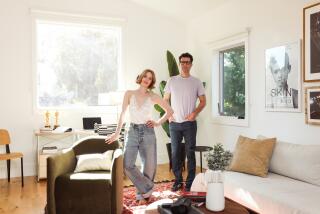DOUBLE UP : The Clarks of Huntington Beach, Like Growing Numbers of Families, Found Heaven 8 Feet Above
HUNTINGTON BEACH — In the old days, Lynn Clark came home to a house when her day was done.
But that was before the metamorphosis.
Now Clark races home to what she describes as “heaven, sheer heaven.”
Clark’s heaven is eight feet above the entry hall floor: an 825-square-foot master bedroom suit she and husband Tom, a retirement and health-plan administrator, added to their 20-year-old tract home.
The Clarks and their two sons are part of an ever-growing number of Orange County families who have found that adding on can be far less expensive than moving, and that with planning and a proper attitude, even as massive an undertaking as a second-story addition doesn’t have to turn life into a bank account-draining hell.
There were moments, of course--such as the time a workman plowed through the downstairs bathroom wall with a power saw while Lynn Clark was inside, changing out of her leotard after an aerobics class.
Or the week the new footings were poured to support the upstairs and every major room in the house had a gaping hole in the floor.
As most homeowners who add on, the Clarks decided about two-thirds of the way through the job that they just might have been crazy to go ahead with the project.
“But it was worth it,” Tom Clark says. “As you look back you realize that there really weren’t very many problems, and the end result is that we have a much, much nicer house without having to change school districts or trade a small mortgage payment and property tax bill for a huge one.”
Builders say that about 80% of the major room additions being done in Orange County these days are second-story jobs.
Upstairs rooms and suites are routinely added even to homes with existing second stories, and rare is the owner of one of the single-level homes that still make up the bulk of the county’s housing stock who hasn’t wondered, at least once, what it would be like to have an upstairs.
Although second-story additions almost always are more expensive than ground-level add-ons, they are popular for reasons both practical and cosmetic.
“Most new homes in the county are two-story homes, so people with an older place go up because they want to copy that newer look,” says builder Anthony F. Palombo of Huntington Beach. Adding on is generally a lot less expensive than coughing up $600,000 or so for a new home to get the same amount of room.
“But there is also the fact that a lot of homes in the county have very small lots, so there isn’t any room to add on unless you go up,” he says. “And people who do have big lots with room for a ground-level addition want to keep that open space, so they very frequently decide on a second story, too.”
Palombo, whose company has been in business since 1923, estimates that the typical second-floor addition runs $125 to $160 a square foot, compared to $100 to $125 per square foot for a ground-floor addition.
A big piece of the cost is the additional engineering and structural reinforcing that has to be done to meet building code and earthquake safety standards.
The second major cost is making room for the stairway--for perhaps the most difficult part of a second-story addition is getting to it.
The Clarks were fortunate. Their home had an exceptionally wide hallway just off the entry that was copious enough to swallow up a modest stairway and still leave room for passage to the downstairs bedrooms. To increase the entry space and make the area feel more open, the front doorway was pushed out several feet.
“But usually you lose at least part of a room, and you have to do something to replace that,” says the Clarks’ builder, Dennis D’Ambra, a Westminster designer-builder specializing in room additions.
Many clients tell their designer or architect that they want a sweeping, curving stairway that makes a major visual impact.
But when the plans come back and they see that they have to give up the entire living room and mortgage their children to make that statement, they typically settle for something a bit more modest.
The layout of a particular house and the homeowners’ own desires and budgets are the primary factors in staircase location, but Palombo suggests that it makes sense to use the front of the house for a stairway to a master suit or group of bedrooms and the rear areas of the house for a stairway to a game room, media room or other entertainment-oriented addition.
In either case, he says, it most often works best to use a downstairs bedroom for the stairs. “You use part of it for the stairwell and turn the rest into a den or a study.”
D’Ambra, whose company does about 100 room additions a year, says the design and engineering phases are the most critical part of a second-story addition.
“It is different than when an architect designs a new house, because we don’t get too many jobs where people have us knock everything down and start all over. We must create from existing conditions.”
Many clients believe that a second-story addition is always less expensive if it sits atop the garage, and while that often is the case, D’Ambra cautions against sacrificing aesthetics to save a few dollars.
“It is usually not that much more costly to add on top of the house proper,” he says, “and it almost always looks better. When a properly designed second story is finished, people who drive by should think the whole house was built at the same time. If someone comes up and says they see you’ve added on, then the designer has done a bad job.”
As part of their remodel, the Clarks added wood siding to the front of their home and used the same siding to tie the addition into the rest of the structure. They also replaced the ground floor front bedroom windows with multipane windows to match those used in the addition’s modest bay.
D’Ambra’s design has the second story nested in the old roof to minimize the height of the addition and the result is a large new second floor that looks as it it has been there all along.
The only sign the house wasn’t built originally as a two-story home is that the Clarks opted not to reroof the whole house when doing an addition. The wood shingles on the existing part of the house had plenty of life, so D’Ambra merely wove new shingles into the old ones where the existing roof tied into the new structure. As a result, the shiny new shingles don’t blend in with the darkly weathered old shingles.
But that is outside and well hidden from view by a large olive tree that shades the front yard.
Inside the house and up the carpeted oak staircase is Lynn Clark’s heaven: a 32-foot by 14-foot master bedroom with vaulted ceilings, a bay window, a small bathroom and an 12 1/2-foot by 6 1/2-foot retreat area with a built-in oak bookcase that was moved from downstairs.
A hidden but key feature of the new room is the walk-in closet. With nearly 225 square feet of floor space, it is larger than the master bedroom of many homes.
The Clarks took advantage of the chaos caused by work on the second-story addition to extensively redecorate the downstairs portion of their homes as well. They had unsightly sprayed-on acoustic ceiling material torn down and the ceilings replastered, the entire house was repainted and new carpeting was laid.
The bill? About $100,000, including $70,000 to D’Ambra for the upstairs addition.
In addition to pouring new foundations and building a support frame for the second floor, which often involves ripping up existing flooring and tearing open interior and exterior walls, the builder has to remove at least a part of the existing roof.
A structural engineer generally is retained to prepare the foundation and framing specifications and to determine whether any other special measures must be used for structural integrity.
In the Clarks’ job, for example, special brackets had to be used to tie the ground floor framing to the foundation, which required that several dozen holes be opened in the exterior stucco for access to the framing and existing foundation. And one wall of the living room had to be opened up so that the interior framing could be tied together with sheets of plywood.
Despite that, Palombo says, a second-story addition often is easier for a builder than a ground-floor add-on.
If the addition is designed properly, the electrical and plumbing connections can be stacked over the existing ground floor systems, and until the staircase is built, most of the work can be done without entering the existing house--which makes life easier for the client.
On the down side, he says, “you are removing the roof of the existing house, and so you expose the residents to the elements and have to seal everything up at the end of every day. And you know that drought or not, when you take off the roof, it will rain.”
Palombo says he always sits down with clients and goes over the job before any work begins to establish what the client expects and to let the client know what will be going on.
What every homeowner about to embark on a remodeling ought to remember, Palombo says, is that: “It is your home, and you are going to be living in it while the work is done. So ask the builder all the questions you can think of.
“Communicate. When you are doing an addition, the only dumb questions are the ones you don’t ask. But try to ask them at the beginning. A builder shouldn’t be put out by a few questions during the course of a day while construction is going on, but when a client is running up or calling with 15 or 20 questions and changes a day, it gets to be hell for everyone.”
In his pep talk, Palombo tells clients “that their basic living style won’t be changed, they can still use the bathrooms and kitchen and things, but that there will be work done that requires some patience and understanding on their part.
“I tell people that the job will go in three stages, as far as their feelings go. At first, they will be thrilled that we are starting. Then they will realize that we are invading their home with an army of people they don’t know. And then, toward then end, they will be impatient for us to get done and get out.”
Perhaps the most important aspect of any remodeling job, of course, is to hire a builder with whom you are comfortable.
“If you find a contractor that you like, but the bid is too high, tell him,” Palombo says.
“Tell him you want him to do the job but can’t afford his bid. Most contractors will negotiate and work something out. Too often, people pick price over the company they are comfortable with, and that is a recipe for trouble, especially in today’s climate, with so many inexperienced people setting up as remodeling contractors.”
The Clarks seem to be proof positive of the benefits of working with a contractor you like.
They first hired D’Ambra Inc. in 1978 to add a 20-foot by 25-foot family room to the rear of their house. The experience prompted them in 1980 to hired the company to do an extensive remodeling of their kitchen.
And when they decided last spring, after five years of on-and-off discussion, to finally take out a second mortgage and add an upstairs, they returned to D’Ambra.
“It is so nice to have someone on the job who knows your likes and dislikes, who you get along with and who is willing to sit down and talk things out,” says Lynn Clark.
D’Ambra uses a computer imaging system to prepare photographic-quality portraits of what a client’s home will look like once the proposed addition is completed, and that picture sold the Clarks.
Also, D’Ambra provided the Clarks with cost estimates of various finishing chores, such as installing baseboard and the shelving systems in the huge master closet, and stepped aside from those parts of the job when the Clarks found other workers, including a neighbor with a handyman business, who would do those jobs for less.
Tom Clark says he figures that accommodation saved him $5,000.
D’Ambra also was understanding when Lynn Clark insisted that this crew preserve the wallpaper in her living room--paper that matched the upholstery on an armchair--even though to do so meant considerably more labor in digging a 4-foot square hole for the footing pad for one of the 4x6-inch posts supporting the addition.
The wall to be saved ran right over the center of the hole and D’Ambra’s crew, instead of walking in the front door and starting, had to cart all of its equipment down a hallway and back through a small bedroom to get to the opposite side of the living room wall and begin digging.
“Things like that are important,” Lynn Clark says, “and they make putting up with the whole job a lot easier.”
THE PROJECT
Lynn and Tom Clark’s 825-square-foot retreat was created by adding a second floor master suite to their Huntington Beach home.
THE NEW
The addition includes a huge walk-in closet, study, shower and bay window. Care was taken in the design to make the addition look like part of the original house.
THE OLD
Including a small bath and closet, the old master bedroom offered only 255 square feet.
FAMILY ROOM
This 20-by-25-foot family room was the first addition to the Clark home.
ON THE GROUND
Work on the first floor was mainly structural. But a new skylight was added to the living room, the front entry was enlarged, plain windows were replaced with multipane models and the facade was covered with wood siding.
More to Read
Sign up for Essential California
The most important California stories and recommendations in your inbox every morning.
You may occasionally receive promotional content from the Los Angeles Times.






